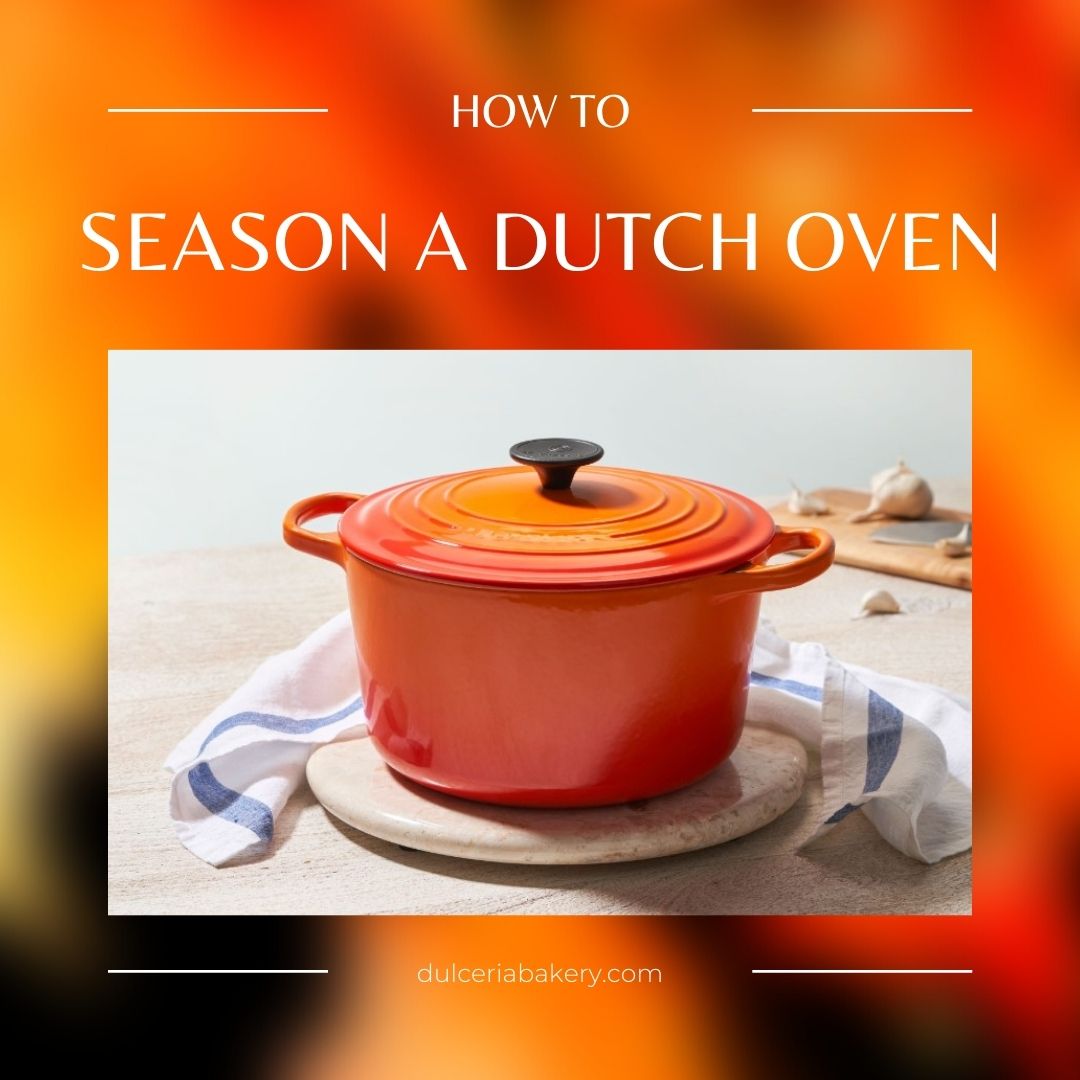If you are planning on cooking with a Dutch oven, it is important to season the pot before use. Seasoning the pot will help to create a natural non-stick surface and give the pot a bit of flavor. There are a few different methods that can be used to season a Dutch oven.
Whichever method you choose, it is important to make sure that you season your Dutch oven before each use. This will help to create a natural non-stick surface and give the pot a bit of flavor. Seasoning your Dutch oven is an effortless process that will help to ensure that your meals come out tasting great every time.
What Does It Mean To Season A Dutch Oven?
When you are cooking with a Dutch oven, proper seasoning is key to getting the best flavor out of your food. But what does it mean to season a Dutch oven, and how do you go about doing it?
To season a Dutch oven, all you need to do is coat the inside with vegetable shortening or cooking oil. Then, bake it in an oven at 350 degrees Fahrenheit for about an hour. This will help create a barrier against moisture and food acids, which can cause your Dutch oven to corrode over time.
If you want to keep your Dutch oven in good condition for as long as possible, it is important to season it regularly. You can do this every time you use it, or every few months if you do not use it very often. Just make sure to give it a good cleaning before you start the seasoning process.
With proper care and seasoning, your Dutch oven will last for many years to come. So, get out there and start cooking up some delicious food!
Why do I need to season my Dutch oven?
If you are new to cooking with a Dutch oven, you might be wondering why it is necessary to season the pot before use. Seasoning is simply the process of coating the cookware with oil or fat, which helps create a nonstick surface and prevents rusting. It is an effortless process that only requires a few minutes of your time, and it is well worth doing to ensure that your Dutch oven lasts for years to come.
What kind of oil do you use to season a Dutch oven?
There are a few different types of oil that can be used to season a Dutch oven, but the most common and recommended type is vegetable oil.
When it comes to choosing a vegetable oil, you can either go with a light or dark variety.
Light oils such as canola or peanut oil will help create a more even coat on your Dutch oven, while dark oils like olive or coconut oil can add a richer flavor. Whichever type of oil you choose, make sure to apply it evenly all over the surface of your pot before cooking.
If you are looking for an alternative to vegetable oil, you can also use shortening, lard, or bacon fat. These options will create a more durable seasoning on your Dutch oven, but they can also add unwanted flavors to your food.
If you do go with one of these alternatives, make sure to apply it sparingly and only on the inside surface of your pot.
No matter what oil you choose, be sure to apply it liberally and give your Dutch oven a good coating. This will help the seasoning stick to the pot and create a durable barrier that will keep your food from sticking.
How To Season A Dutch Oven
Seasoning a Dutch oven is a crucial step in ensuring that your food will not stick to the pot and will taste great every time. To season a Dutch oven, you will need:
- A clean, dry Dutch oven
- Vegetable oil
- A pastry brush or paper towel
- Aluminum foil
- A stove top or oven
Instructions
- Preheat your oven to 350 degrees Fahrenheit.
- Cut a piece of aluminum foil large enough to cover the bottom of the Dutch oven.
- Place the aluminum foil on the bottom of the Dutch oven, then place the pot in the oven.
- Bake the Dutch oven for 30 minutes.
- Remove the pot from the oven and let it cool completely.
- Once it has cooled, apply a thin layer of vegetable shortening to the entire surface of the pot. Be sure to get into all the nooks and crannies.
- Place the pot back in the oven and bake it for another 30 minutes.
- Once again, remove the pot from the oven and let it cool completely.
- Your Dutch oven is now ready to use! Be sure to follow the manufacturer’s instructions when using it, as some require that you season the pot before each use.
With these simple steps, you will be sure to have a Dutch oven that is seasoned perfectly and ready to use for all your cooking needs.
How To Season Cast Iron Dutch Oven
Cast iron Dutch ovens are a great way to cook food. Not only are they sturdy and durable, but they also help to distribute heat evenly, which results in delicious food. However, to get the most out of your cast iron Dutch oven, it is important to season it correctly. Here is how:
- Start by heating up your oven to around 350 degrees Fahrenheit.
- Next, take some vegetable oil or cooking spray and coat the entire inside of the Dutch oven.
- Now, put the Dutch oven in the oven and bake it for around an hour. Make sure to keep an eye on it so that it does not burn.
- Once the hour is up, turn off the oven and let the Dutch oven cool down inside of it.
That is it! Your cast iron Dutch oven is now seasoned and ready to use. Remember to reapply oil or spray every few uses to keep it in good condition.
How To Season An Enamel Dutch Oven
If you are lucky enough to have an enamel Dutch oven, you know that it is a great tool for cooking. But did you know that you need to season your enamel Dutch oven before you use it. Here is how to do it:
- Preheat your oven to 350 degrees Fahrenheit.
- Rub a thin layer of vegetable oil all over the inside and outside of the pot.
- Place the pot upside down on a baking sheet and bake it in the oven for 30 minutes.
- Let the pot cool completely before using it.
Now your enamel Dutch oven is seasoned and ready to use! Enjoy cooking with it!
How Often Do You Season A Dutch Oven?
Dutch ovens are a type of pot that is made from cast iron. They are popular because they heat evenly and retain heat well, making them perfect for slow cooking dishes. Dutch ovens can be used on the stove top or in the oven, making them a versatile piece of cookware.
One crucial step in using a Dutch oven is seasoning it. This means coating the inside with oil and baking it at a high temperature to create a non-stick surface. You should do this before your first use, and then every few months thereafter.
How often you need to season your Dutch oven depends on how often you use it. If you only use it once or twice a year, you may need to season it every time you use it. But if you use it regularly, you can season it less often.
If you notice that your Dutch oven is starting to stick, or the surface is looking dull, it is probably time to season it again. To season your Dutch oven, simply wipe the inside with a layer of oil and bake it at an elevated temperature for 30 minutes. This will help create a non-stick surface and keep your Dutch oven in good condition.
How do you maintain a Dutch oven
A Dutch oven is a versatile kitchen tool that can be used for baking, braising, roasting, and more. While it is a durable piece of cookware, it does require some maintenance to keep it in good condition. Here are some tips for maintaining your Dutch oven:
- Seasoning: Seasoning your Dutch oven helps to create a non-stick surface and also prevents rust. To season your Dutch oven, simply rub it with cooking oil and then bake it in a preheated oven for 30 minutes. Be sure to do this before each use.
- Cleaning: After each use, clean your Dutch oven with hot water and mild soap. Avoid using harsh detergents or scrubbing pads, as they can damage the surface of the pot.
- Storage: Store your Dutch oven in a cool, dry place. Avoid storing it in direct sunlight or near heat sources. If you plan on using it regularly, it’s a good idea to keep it seasoned and ready to go by storing it in a zip-top bag with a few drops of cooking oil.
That is it! With these tips, your Dutch oven will stay in good condition for years to come.
How To Season A Dutch Oven – FAQs
If you are new to cooking with a Dutch oven, the process of seasoning one can seem a bit daunting. Here are answers to some frequently asked questions about seasoning a Dutch oven, to help you get started.
Seasoning a Dutch oven is the process of creating a non-stick surface on the pot by heating and oiling it. This is typically done before first use, and occasionally thereafter as needed.
Seasoning your Dutch oven creates a non-stick surface that will make it easier to cook with and clean. Additionally, it helps to prevent rust and corrosion on the pot.
There are a few different methods for seasoning a Dutch oven, but the most common is to simply rub the pot with oil and bake it in a hot oven.
Yes, you can season your Dutch oven with vegetable oil. Any type of oil will work, but some may be better suited to your needs than others. For example, olive oil has a lower smoke point than other oils, so it may not be the best choice for high-heat cooking.
There is no one “best” way to season a Dutch oven, as there are several methods that can be used effectively. The important thing is to choose a method that you are comfortable with and that will work well for your needs.
If you do not season your Dutch oven, it is more likely to rust and corrode. Additionally, the pot may be more difficult to clean and use.
You should season your Dutch oven as needed, depending on how often you use it. If you use it frequently, you may need to season it more often than if you use it infrequently.
At what temperature should I season cast iron? The best temperature to season cast iron is between 350-400 degrees Fahrenheit. Seasoning cast iron at this temperature will help the oils bond to the surface of the pan, creating a smooth, non-stick finish.
The smoke point of olive oil is around 375 degrees Fahrenheit. This means that it may not be the best choice for high-heat cooking.
The smoke point of vegetable oil is around 400 degrees Fahrenheit. This makes it a better choice for high-heat cooking than olive oil.
The best way to tell if your Dutch oven is seasoned enough is to try cooking with it. If the pot does not stick or corrode, it is likely properly seasoned.
Yes, there is a difference between seasoning a Dutch oven and seasoning a cast iron skillet. Seasoning a Dutch oven involves creating a non-stick surface on the pot, while seasoning a cast iron skillet involves coating the pan with oil and baking it in a hot oven. This helps to create a non-stick surface as well as prevent rust and corrosion.
The best way to clean a seasoned Dutch oven is to simply wipe it out with a damp cloth after each use. You should avoid using soap, as this can strip away the seasoning. If you need to scrub the pot, use a non-abrasive sponge or brush.
Yes, using soap will strip away the seasoning on your Dutch oven and make it more difficult to season again. It is best to avoid using soap if possible.
If your Dutch oven is starting to rust, you can try scrubbing it with a non-abrasive sponge or brush to remove the rust. You can also try coating it with a layer of oil to help prevent future rusting.
Yes, you can use your Dutch oven on the stovetop. However, you should avoid using high heat, as this can damage the pot.
Yes, you can use your Dutch oven in the oven. However, you should avoid using temperatures higher than 500 degrees Fahrenheit, as this may damage the pot.
No, you should not put your Dutch oven in the dishwasher. The high temperatures and harsh chemicals can damage the pot.
If your Dutch oven is starting to lose its non-stick properties, you can try seasoning it again. This will help to create a new non-stick surface on the pot.
If your trusty cast-iron Dutch oven has seen better days, do not despair! With a little challenging work and some patience, you can bring it back to its former glory. Here is how to reseason a cast-iron Dutch oven:
- First, wash the pot with warm, soapy water. Use a stiff brush to remove any rust or food residue. Rinse well and dry thoroughly.
- Next, coat the inside and outside of the pot with a thin layer of vegetable oil. Use a paper towel to spread the oil evenly over the surface.
- Place the pot upside down on the top rack of your oven and preheat to 350 degrees Fahrenheit. Allow the pot to heat for about an hour to allow the oil to penetrate the metal.
- After an hour, turn off the oven and allow the pot to cool completely. Once it is cooled, you can use it as usual!
With a little time, your cast-iron Dutch oven will be good as new. Enjoy!
Conclusion
Now that you know how to season a Dutch oven, it is time to reflect on the process. Seasoning a Dutch oven is not difficult, but it is important to follow the steps correctly to achieve the best results. By seasoning your Dutch oven, you can ensure that it will be long-lasting and durable.
Seasoning a Dutch oven also gives it a nice flavor and texture, which will enhance your cooking experience. So why not give it a try? Follow the steps outlined in this article, and you will be able to season your Dutch oven like a pro. Thanks for reading!
Read more:
- STAUB Pumpkin Dutch oven
- DASH Turbo POP Popcorn Maker Review
- What can you use a panini press for?
- What is the best sandwich maker with removable plates?
- Ovente Electric Sandwich Maker Reviews
- Is BLACK+DECKER WM2000SD Sandwich Maker worth it?
- DASH Everyday Ice Cream Maker
- Ninja NC299AMZ CREAMi Ice Cream Maker
- Cuisinart ICE-45P1 Soft Serve Ice Cream Maker
- Hamilton Beach Electric Automatic Ice Cream Maker
Related Posts
The Best Dutch Oven For Bread: A Comprehensive Guide
Disclaimer: There are affiliate links in this post. At no...
Read MoreBest Dutch Oven For Sourdough Bread
Disclaimer: There are affiliate links in this post. At no...
Read MoreBest Dutch Oven For Camping
Disclaimer: There are affiliate links in this post. At no...
Read MoreWhy Trust Us
You will find what you are looking for at dulceriabakery. From classic to luxury brands, you'll find both. We will help you to select appliances that fit your needs, budget and lifestyle. Whether you want to stop by to learn more — or plan to make a major purchase — we’ll treat you like family and assist you every step of the way. Shop with us today to receive friendly and experienced help along the way.




